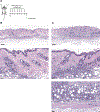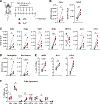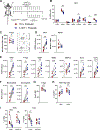Interleukin-2-induced skin inflammation
- PMID: 38430129
- PMCID: PMC11015984
- DOI: 10.1002/eji.202350580
Interleukin-2-induced skin inflammation
Abstract
Recombinant human IL-2 has been used to treat inflammatory diseases and cancer; however, side effects like skin rashes limit the use of this therapeutic. To identify key molecules and cells inducing this side effect, we characterized IL-2-induced cutaneous immune reactions and investigated the relevance of CD25 (IL-2 receptor α) in the process. We injected IL-2 intradermally into WT mice and observed increases in immune cell subsets in the skin with preferential increases in frequencies of IL-4- and IL-13-producing group 2 innate lymphoid cells and IL-17-producing dermal γδ T cells. This overall led to a shift toward type 2/type 17 immune responses. In addition, using a novel topical genetic deletion approach, we reduced CD25 on skin, specifically on all cutaneous cells, and found that IL-2-dependent effects were reduced, hinting that CD25 - at least partly - induces this skin inflammation. Reduction of CD25 specifically on skin Tregs further augmented IL-2-induced immune cell infiltration, hinting that CD25 on skin Tregs is crucial to restrain IL-2-induced inflammation. Overall, our data support that innate lymphoid immune cells are key cells inducing side effects during IL-2 therapy and underline the significance of CD25 in this process.
Keywords: Drug‐induced skin inflammation; IL‐2 therapy; Immunotherapy; Innate lymphoid cells; γδ T cells.
© 2024 The Authors. European Journal of Immunology published by Wiley‐VCH GmbH.
Conflict of interest statement
Conflict of interest
The authors declare that they have no competing interests.
Figures





References
-
- Wolkenstein P, Chosidow O, Wechsler J, Guillaume J-C, Lescs M-C, Brandely M, Avril M-F, Revuz J. Cutaneous side effects associated with interleukin 2 administration for metastatic melanoma. Journal of the American Academy of Dermatology 1993;28:66–70. - PubMed
-
- Raeber ME, Sahin D, Boyman O. Interleukin-2-based therapies in cancer. Sci Transl Med 2022;14:eabo5409. - PubMed
-
- Yu A, Snowhite I, Vendrame F, Rosenzwajg M, Klatzmann D, Pugliese A, Malek TR. Selective IL-2 responsiveness of regulatory T cells through multiple intrinsic mechanisms supports the use of low-dose IL-2 therapy in type 1 diabetes. Diabetes 2015;64:2172–83. - PubMed
MeSH terms
Substances
Grants and funding
LinkOut - more resources
Full Text Sources
Molecular Biology Databases

